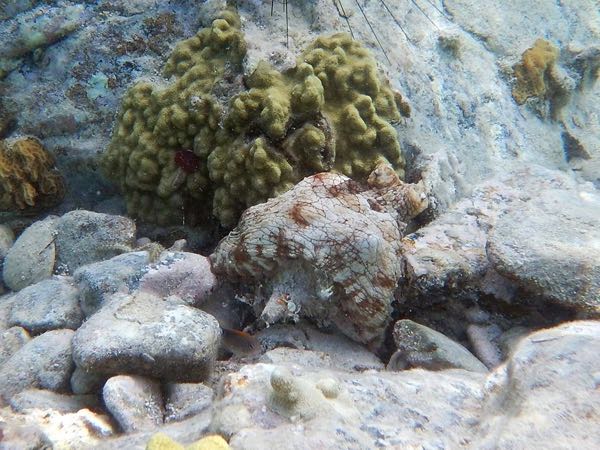
Hello everyone and happy Monday! The National Park Service conducted a presentation over the weekend about the status of our coral reefs. The speakers were Jeff Miller, a National Park Service employee, and Dr. Caroline Rogers of the USGS. Here are their observations after studying the reefs around St. John since the hurricanes:
“The damage you see depends on where you look,” Jeff said. He stated that the relatively low lying reefs, which are located in depths of 20 feet or less, are doing “ok.” Examples of these low lying reefs can be found at Trunk and Cinnamon near the cays, and also at Salt Pond Grootpan and Kiddle.
The higher profile reefs where coral grows up and off the ground, and are often found in locations deeper than 20 feet, were vulnerable to toppling. “Just because it’s knocked over doesn’t mean it’s the end of things,” Jeff said. These toppled reefs can become habitats for other things to grow on top of them.
The North Shore beaches – Honeymoon, Salomon, Hawksnest, Trunk, Cinnamon, Maho, Francis, Leinster and Waterlemon – all had moderate damage. There were some toppled or displaced corals, and also large trees and debris found on the reefs. However, there is still many corals still attached to the bottom of the ocean and in growth positions in these areas, Jeff said.
The higher profile reefs – Haulover, Mennebeck and Tektite, for example – took the brunt of energy from the storms. In these areas, there is abundant, large fleshy algae, and thick “piles” of decaying leaves and sticks.
Leinster Bay, he said, “tells the whole story.” The three buoys area looks like someone took their arm and wiped it away, whereas Waterlemon, which is just a half mile away, looks pretty close to what it looked like prior to the storms.
So what what exactly happened during the storms? Well the reef structure was obviously broken down. Preliminary findings show that there has been a 20 percent decline in soft corals and sea fans. Preliminary findings also show that there has been a 60 percent decline in sponges.
Historically, fish numbers have dipped following large storms, but they have always come back. Jeff likened it to having a house that is messed up in some way. You don’t want to live there during the repairs. That’s pretty much what’s happening with our fish right now. They’ve relocated for a bit, but they should come back in time.
Now on to some better news…
The pillar corals did ok and are already growing back. The NPS has noticed that there has been less than an inch of growth in the past six months. It may sounds small, but that’s great news. “The conditions are still ripe for coral growth to occur,” Jeff said. ”
Some key takeaways according to Jeff:
- Every living piece of coral is more important than ever.
- They survived the storms, so we need to continue protecting them.
- Please do not step on them.
- Please do not drop anchor on them.
- Our National Parks are more important than ever as they allow plants and animals to recover from major disturbances.
- It’s never going to be like it was before September 6th, Jeff said. But our children and our children’s children may be able to see the reefs in their glory once again.
Dr. Caroline Rogers spoke next. What really struck me about her portion of the presentation was with regard to the mangroves. For those of you who have been on island over the past several months, you may have noticed that the majority of our mangroves look dead. Annaberg is a particularly sad sight in my opinion. Dr. Rogers said that the red mangroves found around the island do not sprout new growth. Instead they depend on the growth of new seedlings, she said. Dr. Rogers estimated that it will take 10 to 12 years for these new seedlings to reach 25 feet, the approximate height of the mangroves that were damaged during the storms.

The mangroves served as a major habitat for corals. In Hurricane Hole alone, there were 30 species of coral living at their roots. Those corals, like everywhere else, took a hit. Dr. Rogers said that members of the US Geological Survey will be on island this summer and will begin monitoring these areas.
So overall, there was some good news and some not-so-good news. But Dr. Rogers ended on a very positive note:
“There is hope,” she said.


Do certain types of suntan lotions have a negative impact on the coral? If so, can someone list what ingredients/brands will not have a negative impact? That way, us sunbathing folks can do our part.
Do a search on Amazon for reef friendly sunscreen. There are a bunch of brands. Thanks for asking. It makes a difference.
Oxybenzone free sunscreens.
Check out http://www.tropicalsnorkeling.com/best-snorkeling-sunscreen.html
I need to make a correction here. Haulover is in very good shape. Jeff said so and I snorkeled both North and South and they were the best during my month’s stay in March. Yawze Point, a high profile reef, was damaged.
His comments on this begin around 9:41 – https://www.facebook.com/friendsvinp/videos/1732131103492536/
Thanks for the update on the coral reefs Jen! We can’t wait to come back and do some snorkeling!
For the record, the presentation was organized and hosted by Friends of VI National Park, Same for the presentation on the state of the forests and island flora by Eleanor Gibney on 4/16.
How did Salt Pond fare in the hurricane last and what news if any is there to report on any sale of the Concordia Eco Tent area. Crossing my fingers that it does not become a high-end resort type place. We need more natural setting type places and Stanley’s vision needs to be continued.